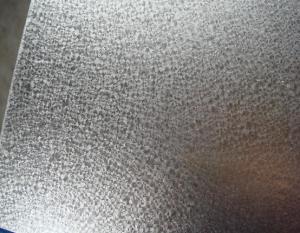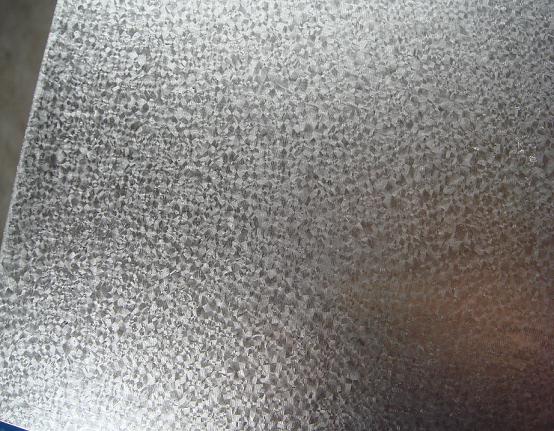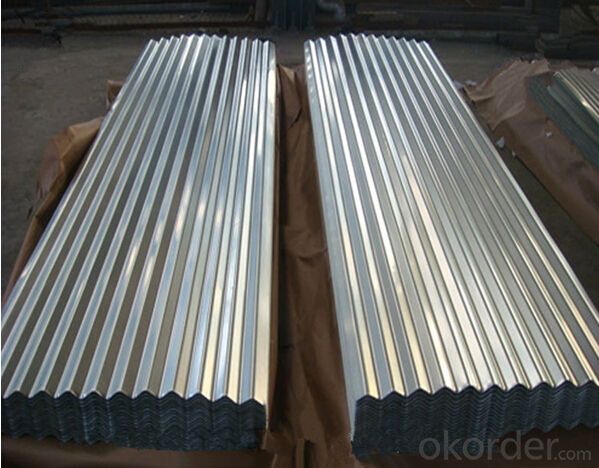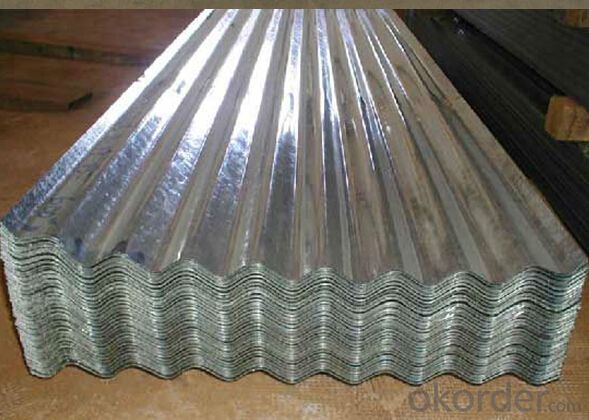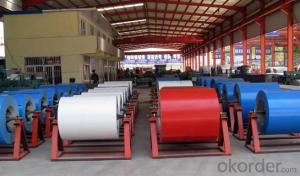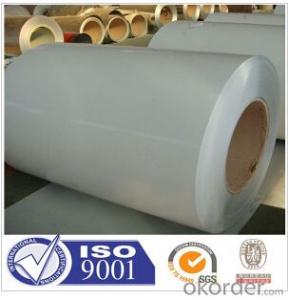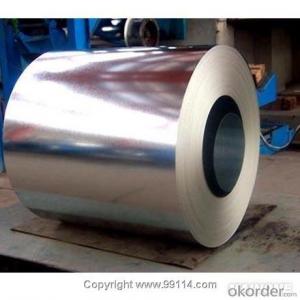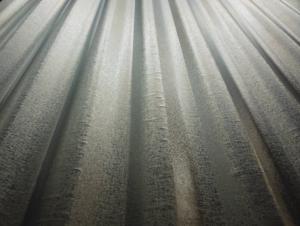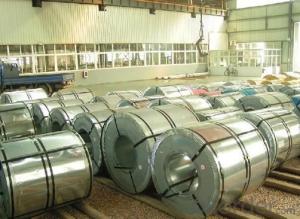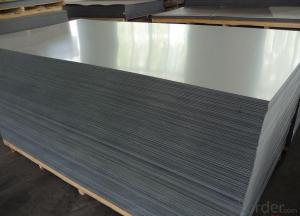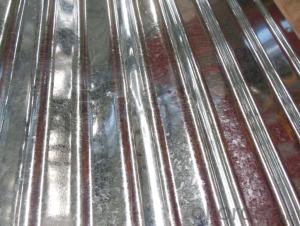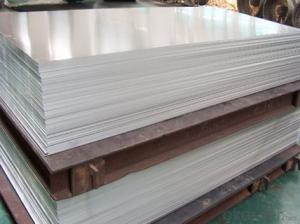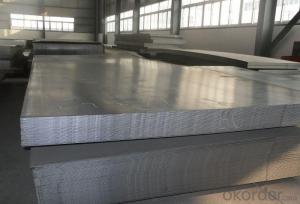Galvalume Corrugated Roofing Sheet
- Loading Port:
- China Main Port
- Payment Terms:
- TT OR LC
- Min Order Qty:
- -
- Supply Capability:
- -
OKorder Service Pledge
OKorder Financial Service
You Might Also Like
Specification:
Product name | Galvalume Corrugated Roofing Sheet |
thickness | 0.3mm-2.0mm |
width before corrugated | 600mm-1500mm |
aluzinc coating | 30g-225g |
standard | AISI,ASTM,DIN,JIS |
grade | SGLCC/SGLCD/SGLC490/SGLC570/CS TypeA,B,C/DS/255/DX51D+AZ/DX52D+AZ/S250GD+AZ/S350GD+AZ/S550GD+AZ |
surface structure | zero spangle, minimum spangle or normal spangle |
surface treatment | Chromate treatment, Oiled/Dry |
packing | 1. standard seaworthy package : waterproof paper/iron sheet/steel strip/steel pallet 2. According to customers' requirements |
payment | T/T or L/C |
min order | 25 tons |
delivery time | within 40 days upon receipt original L/C or advance payment |
Application | various roofs or walls referring to the large size factory buildings, storages, exhibition halls, gymnasiums etc. |
:
Chemical Composition
| |||||||||||||||||||||||||||||||||||||||||||||||||||||||||||||||
- Q: What are the challenges in the production of steel coils?
- The production process of steel coils encounters several obstacles. Firstly, ensuring consistent quality throughout the process is a major challenge. It is necessary for steel coils to possess uniform thickness, width, and flatness. However, achieving this consistently can prove to be difficult due to variations in raw materials, equipment, and operating conditions. Another hurdle involves effectively managing the intense temperatures involved in the production process. Steel coils are formed by heating steel slabs or billets to extremely high temperatures and subsequently rolling them into coils. Maintaining the necessary temperatures and ensuring proper cooling can be a complex task, as any deviations can result in inconsistencies in the final product. Furthermore, the production of steel coils demands a significant amount of energy. The steel industry ranks among the largest energy consumers worldwide. The constant challenge lies in reducing energy consumption while maintaining production efficiency. To tackle this challenge, the implementation of energy-efficient technologies and process optimization is imperative. Moreover, the production of steel coils generates a substantial amount of waste and emissions. Steel manufacturing involves various chemical reactions that release pollutants such as carbon dioxide, sulfur dioxide, and particulate matter. Meeting environmental regulations and minimizing these emissions are significant challenges for the industry. Additionally, the production of steel coils often involves large quantities, necessitating efficient logistics and transportation systems. Ensuring timely delivery and minimizing damage during transportation can be challenging due to the weight and size of the coils. Lastly, the steel industry confronts market challenges, including fluctuating prices of raw materials, competition from alternative materials, and global economic conditions. Adapting to market demands and maintaining competitiveness are vital for the sustainable production of steel coils. Overall, the challenges in steel coil production encompass maintaining consistent quality, managing high temperatures, reducing energy consumption and emissions, optimizing logistics and transportation, and adapting to market dynamics. Addressing these challenges requires continuous innovation, technological advancements, and a focus on sustainability.
- Q: I own a crappy steel string acoustic and a very nice electric guitar.I have saved up to buy a new acoustic but I cannot decide to just invest in a better steel string or explore around with a nylon string. From others experience, will I get my fill of satisfaction of playing on a nylon, or should I stick to a steel string?
- Really?! I think you would be more satisfied with a harmonica. And that is because I know you better than you know yourself. But, if you like steel, go for a 12-string.
- Q: 1045 surgical steel.
- There are many ways to sharpen knives. I guess your question is whether to use the steel that comes with knives, or a stone. Steels are only to straighten the edge, which is stropping. They won't sharpen a truly dull knife. For that you need a real sharpening system, of which a whet stone is one. The edge of a knife will get wavy with use - that's what the steel is for, to true it back up.
- Q: im buying a sword and i dont know if i should buy a cold steel sword or a normal sword and that i can some how make that cold steel
- Cold Steel takes a billet (read piece of metal stock) in high carbon steel, usually 1060 which is pretty good, and then heats it up and pounds it into shape with a pre-made form. This is called forging. Their swords are not Folded (the traditional manner) they are Forged. This is different from taking a piece of 1060 steel and just grinding it down into shape. The forging process creates very strong steel (not as strong as folding) that is much stronger than a sword or knife made from grinding a piece of metal down into shape. Cold Steel's stuff is generally thicker, but they are practical and with enough practice you can wield it just like a thinner lighter sword. Their weapons are what you would call battle ready meaning you could feasibly take it into a sword fight and use it like its more traditionally crafted counter part. The only downfall is its weight and and the fact that it isn't as strong as a folded steel sword, but it would do very well.
- Q: I received a very nice set of stainless steel cookware as a wedding gift. While very pretty, Im finding them almost useless for cooking. Everything sticks, they're difficult to clean, and Im using my old non-stick pans instead. Should I simply leave the stainless out for decortive purposes, or are stainless steel pans better for some applications?
- This Site Might Help You. RE: Why should I use stainless steel cookware? I received a very nice set of stainless steel cookware as a wedding gift. While very pretty, Im finding them almost useless for cooking. Everything sticks, they're difficult to clean, and Im using my old non-stick pans instead. Should I simply leave the stainless out for decortive purposes, or...
- Q: Can steel coils be coated with copper?
- Yes, steel coils can be coated with copper.
- Q: steel strutural
- how much of IS2062-92
- Q: Why people prefer prefabricated buildings these days? Recently my friend has told me that he is going to owe a steel house so I was just thinking are these steel structures really durable and cheaper than concrete structures?
- It really depends upon the environment and the construction techniques used. Steel that is painted or coated will without maintenance eventually rust. I would expect this tendency to be exacerbated in a humid or shore environment. Heat may tend to cook a steel house and the structure does not add much thermal mass. Construction techniques tend to be fairly quick a part of the construction is essentially prefabricated. Work done in a factory will almost always be cheaper than work done in the field, all things being equal. Concrete can be fairly hi tech with lots of equipment or as seen in many parts of the world fairly low tech with lots of laborers. It is easy to change the characteristics of concrete depending upon how it is mixed, reinforced, and treated during the curing process. Because it is applied in a relatively fluid state it can flow around obstructions like bedrock and be formed up into interesting shapes. A concrete structure can be cooler as it provides thermal mass, and a heat sink. It's resulting rigidity may make it more subject to earthquakes than steel. We do really need to be smarter in constructing our homes to make them fit the land and not only the general environment but our particular micro environment.
- Q: Steel steps steel guard rail steel chair. You see where I'm going with this.
- Lex Luger's right elbow... OH YESH!!!! I SEE WERE YOU ARE GOING WITH THIS!!!
- Q: What are the common defects in steel coil finishes?
- Steel coil finishes can be affected by various defects that can impact both their appearance and functionality. Before using or selling the coil, these defects may need to be addressed. One common defect is coil breaks, where the steel strip breaks during winding or unwinding. If not dealt with, this defect can cause a discontinuity in the coil's surface and potentially lead to further damage. Another defect is edge wave, which refers to a distortion or waviness at the edges of the coil. This can occur during the rolling or cooling process and can affect the coil's flatness and uniformity. Corrosion is another issue that can arise if steel coils are not properly protected or stored. This can result in rust and degradation of the steel, impacting its strength and appearance. Streaks and stains can appear on the surface of steel coils due to improper cleaning or contamination during production. These defects can affect the aesthetic appearance of the steel and may need to be addressed before use. Scratches and dents can occur during handling, transportation, or storage of steel coils. These defects can impact the flatness and surface quality of the steel and may require repairs or adjustments. If a coating or paint is applied to the steel coil, several defects can arise, including blistering, peeling, or uneven application. These coating defects can affect the durability and appearance of the steel. It's important to note that the severity of these defects can vary, and different methods of repair or mitigation may be needed. Regular inspections and quality control measures can help to identify and address these defects before they become more significant issues.
Send your message to us
Galvalume Corrugated Roofing Sheet
- Loading Port:
- China Main Port
- Payment Terms:
- TT OR LC
- Min Order Qty:
- -
- Supply Capability:
- -
OKorder Service Pledge
OKorder Financial Service
Similar products
Hot products
Hot Searches
Related keywords
